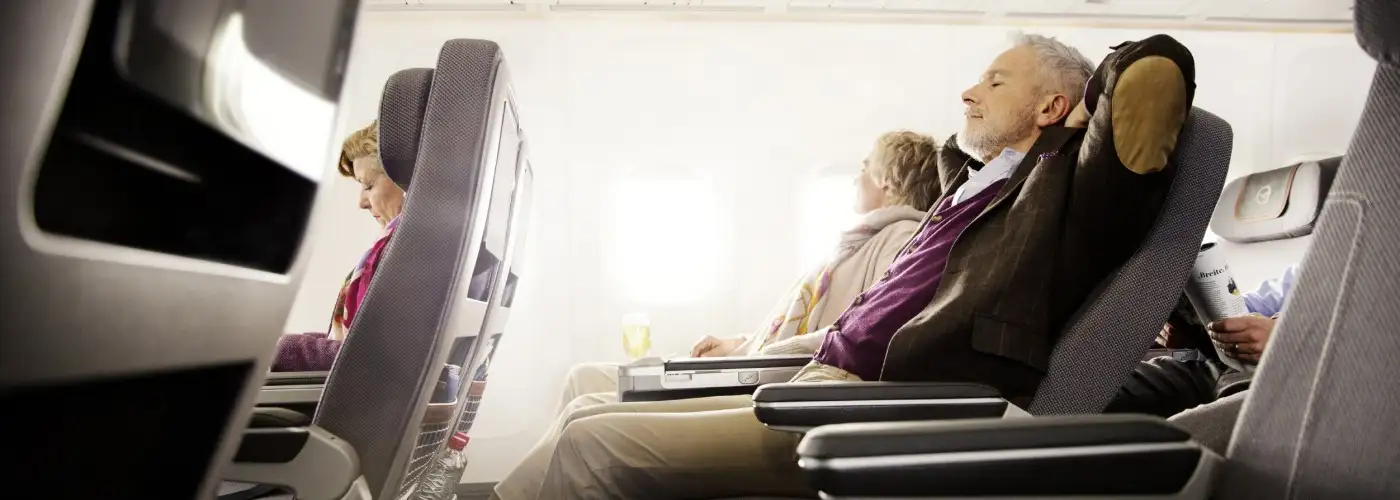Lufthansa is the latest major holdout to join the group of giant airlines offering premium-economy class. All newly delivered 747-8s incorporate the new cabin, with initial routes linking Frankfurt with Chicago, Los Angeles, and Washington. The airline will start offering premium economy on its A380s and A340s next spring, with installation completed by the end of next year. Lufthansa’s product will closely resemble that of Air France.
Lufthansa’s announcement suggests an overall update of premium economy. The basic idea is simple: The gap between economy class and business class has become immense over the last decade, in both product quality and cost. Here’s how:
- Among the world’s major airlines, business class has become opulent beyond anyone’s wildest expectations. The emerging norm is seats that convert to fully horizontal lie-flat beds for overnight flights, elaborate meal service, generous baggage allowances, and special ground facilities and services; airlines currently operating business class with seats that convert to flat beds at an angle are rushing to convert to the lie-flat design. Business class has become so lavish that many lines have completely abandoned first class.
- Economy class, on the other hand, keeps getting worse: ever-tightening legroom, narrower seats, minimal cabin service, fees for practically everything, and general cattle-car treatment.
- The difference is reflected in the fares: From Boston to London in mid-November, for example, current economy round-trip fares for nonstop flights start at $800, while business class starts at $6,000, more than seven times as much.
Enter premium economy: better than regular economy, cheaper than business class. But different airlines have implemented this idea in different ways. Most big Asian, European, and Pacific lines have opted for what I call “genuine” premium economy. Seats are 2–3 inches wider at shoulder level than seats in regular economy, meal and beverage services are better, extras do not require fees, and most lines provide preferred check-in lines. Standard layouts are 2-2-2 in 767s; 2-3-2 in A330-340s, A380 upper decks, and 787s; and 2-4-2 in 747s and 777s. Seat pitch (front-to-rear spacing of set rows) of 37–40 inches provides 6–8 inches more legroom than conventional economy. Air Canada is the only North American line to offer genuine premium economy on a few planes.
Fare differences are inconsistent, but premium is typically 60 percent to 90 percent higher than regular economy. Here are some sample round-trip fares for nonstop travel in mid-February:
- From Washington to Frankfurt on Lufthansa: $1,635 in premium compared to $1,237 in economy.
- New York to Paris on Air France: $1,479 in premium compared to $1,239 in economy.
- New York to London on British Airways: $1,526 in premium compared to $973 in economy.
- Los Angeles to Taipei on EVA: $1,608 in premium compared to $973 in economy.
No U.S. airline offers genuine premium economy; instead, many now offer what I call semi-premium economy—regular narrow economy seats with an extra 3–6 inches of legroom—at fares up to $150 or so more than regular economy. KLM also uses this system.
I know of only two airlines that offer a premium-economy approach in 757s: OpenSkies, with what seems to be above average service at good prices (although I haven’t been able to try it), and Icelandair, which touts its equivalent service as a business class but is really about the same as other lines’ premium economy. And the “business class” featured by the several charter-style airlines that fly across the Atlantic is actually about what other lines would call premium economy.
All this leads to three conclusions:
- Premium economy generally seems to target business travelers whose companies won’t pay for business class. Prices are too stiff to appeal to all but the most affluent vacation travelers.
- But when it’s on sale, as currently with Air France, premium economy can look attractive enough to tempt leisure travelers who are fed up with the miseries of regular economy. If you’re interested, keep on the lookout for premium “sales.”
- No U.S. airlines seem likely to switch to genuine premium economy anytime soon. But they sell it—and you can access it—on flights operated by codeshare partners.
These days, most big metasearch engines and online travel agencies provide price searches for premium economy. And airline-seating websites such as SeatGuru post seating details.
Ed Perkins on Travel is copyright (c) 2014 Tribune Media Services, Inc.
You Might Also Like:
We hand-pick everything we recommend and select items through testing and reviews. Some products are sent to us free of charge with no incentive to offer a favorable review. We offer our unbiased opinions and do not accept compensation to review products. All items are in stock and prices are accurate at the time of publication. If you buy something through our links, we may earn a commission.
Related
Top Fares From Columbus, OH
Today's Top Travel Deals
Brought to you by ShermansTravel
Shop and Save with Country Inns...
Patricia Magaña
 Hotel & Lodging Deals
Hotel & Lodging Deals
$229 -- Chicago: Discounted Rates and...
Francesca Miele
 Hotel & Lodging Deals
$229+
Hotel & Lodging Deals
$229+
$188 -- Honolulu: Save on Oceanview...
Abigail Lamay
 Hotel & Lodging Deals
$188+
Hotel & Lodging Deals
$188+




